How to grow carrots
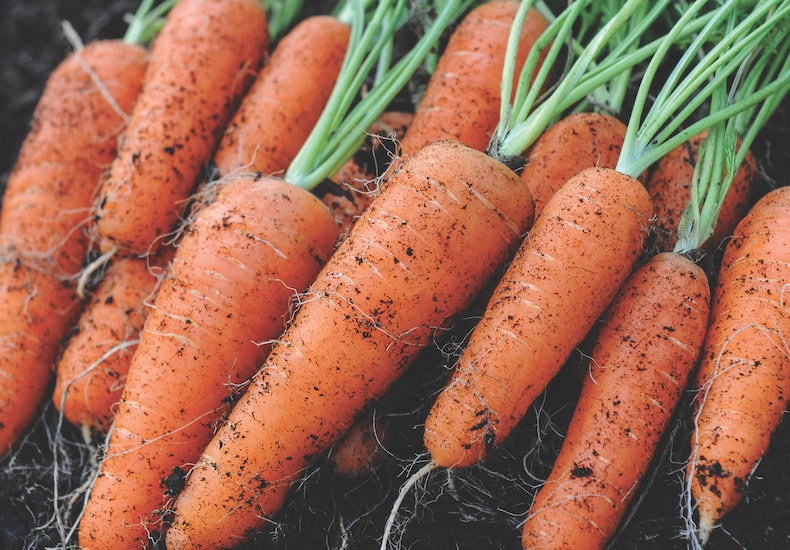
This delicious cupboard staple tastes even better when you grow it yourself!
Image: Carrot 'Flyaway' F1 Hybrid from Thompson & Morgan
Carrots are a tasty and versatile root vegetable. They’re easy to grow, too, so they’re ideal for novice gardeners as well as those with more experienced green-fingers. See our handy guide below for tips on when to sow carrots and how to grow them from seed.
When to sow carrot seeds
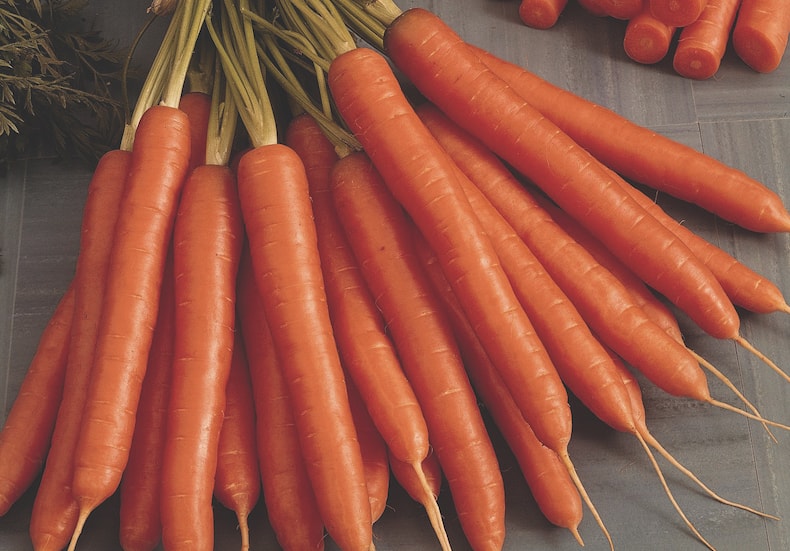
'Amsterdam Forcing' is an early maturing variety and can be sown in February
Image: Carrot 'Amsterdam Forcing' from Thompson & Morgan
Carrot seeds can be sown from early spring right through to late August and can be harvested almost all year round.
Most varieties are sown outdoors between April and July. Early cultivars such as the ‘Nantes 2’ can be sown under a cloche or started in greenhouses from February. Check the seed packet if you’re unsure when to sow your chosen variety.
For a spring harvest, you can grow carrots in a greenhouse throughout the winter. However, as a general rule, they prefer to be cool and don’t do well in greenhouses during the hotter summer months.
Choose a sunny spot with light, fertile soil and good drainage. Heavy and stony soils, or clay-based beds can make growing more difficult, but short-rooted varieties like ‘Caracas’ can still do well in these conditions.
Add plenty of organic matter to the soil before sowing but remember that carrots dislike freshly manured earth. Prepare your beds the autumn before to allow a period of rest before planting.
For further information on different varieties, have a look at guide:
| Early | Maincrop | Chantenay (good for containers) | Colourful varieties |
|---|---|---|---|
| Nantes 2 | Norfolk | Caracas | Sweet Imperator Mix |
| Adelaide | Autumn King 2 | Chantenay Red Cored 3 - Supreme | Cosmic Purple |
| Amsterdam Forcing | Bangor | Purple Sun |
How to sow carrot seeds
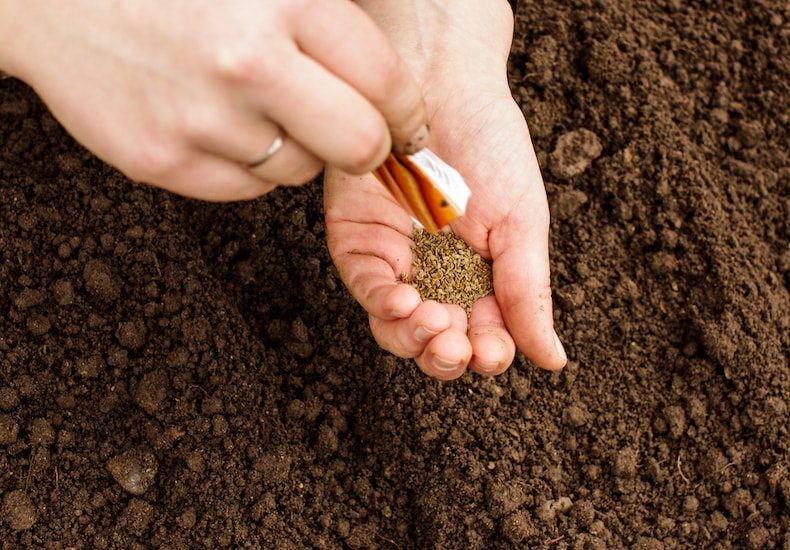
Leave each seed plenty of room and thin the plants out as they grow
Image: Shutterstock
Before sowing, weed the seedbed well and break up any larger lumps of soil, digging to a fine tilth. Water the ground before marking out rows 30cm (12in) apart and 0.5-1cm deep. Carrots need to be sown shallowly.
Sow your seeds roughly 5cm (2in) apart to reduce overcrowding and to make it easier to thin out the seedlings later on. It’s a good idea to sow just a little thicker than the desired final crop. This allows for losses due to poor germination or other growing issues.
Cover the seeds very lightly and water the area as gently as you can with a fine-rose watering can to minimise disturbance. Keep the soil moist until the seeds germinate, which usually takes between 10-20 days.
Caring for your carrots
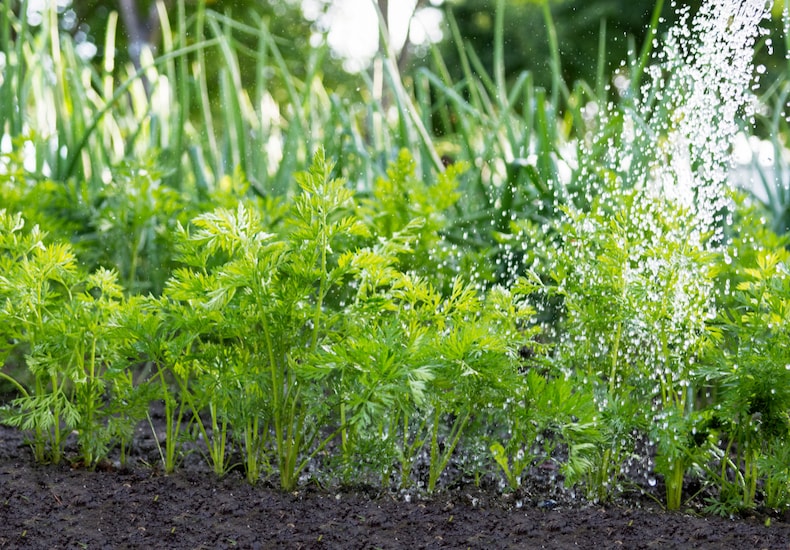
Be careful not to overwater which can lead to splitting or ro
Image: Jurga Jot/Shutterstock
If seedlings are too close together, thin out the weakest plants to give each room to grow and prevent them competing for nutrients. A great tip is to thin out in stages, so you’ll have spare seedlings in the event of a slug or pest attack. Weed regularly to retain precious resources in the soil for your plants.
Carrots are reasonably drought-resistant once they’ve germinated. Water minimally but consistently - too much fluctuation in moisture can lead to split roots. And if the shoulders of your carrots start to show above the soil, earth them up slightly to prevent them from turning green.
How to grow carrots in containers
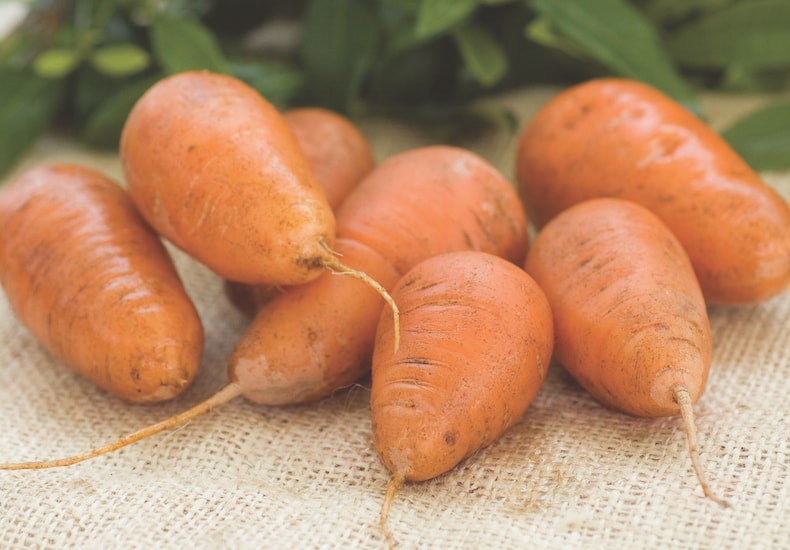
With shorter roots, carrot 'Caracas' can be grown by urban gardeners in containers
Image: Carrot 'Caracas' - Kew Collection Seeds from Thompson & Morgan
Containers are just as good as veg patches if you use the right variety, so don’t be put off if you don’t have a large garden. Patios and balconies can be great little growing spaces.
Choose a container that’s about 45cm (18in) deep to give the roots as much space as possible. Small or early varieties like ‘Paris Market - Atlas’ or Chantenay varieties such as ‘Chantenay Red Cored 3 - Supreme’ are the most successful for growing in pots.
Choose a soft, humus-based soil with a pH level of 6.0-6.8 and feed your plants regularly throughout the season to ensure good growth. Try using a potassium-rich liquid feed fortnightly or a slow-release fertiliser. Keep the container moist and watch out for dry compost in warmer weather.
When to harvest carrots
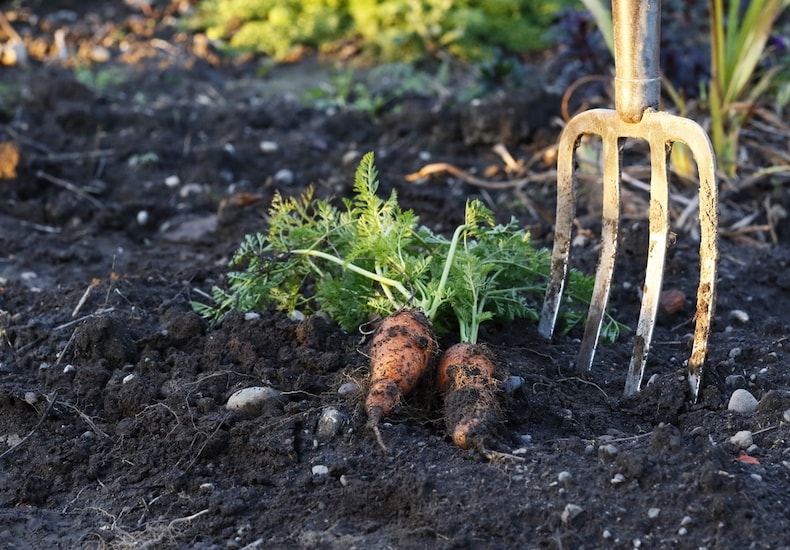
Gently prise carrots from the ground with your hands or a fork
Image: theapflueger/Shutterstock
Depending upon the variety and growing conditions, you should be able to harvest most carrots between 12 and 16 weeks after sowing. Fast-growing autumn-sowing varieties such as ‘Nantes Frubund’ can be ready by mid-February. The best way to ensure your carrots are ready is to pull one or two test plants to see how they’re doing.
Carrots can be stored in the refrigerator with their green tops removed for 2-4 weeks, or in a bucket of slightly damp sand in a cool, dry place for up to 4 months. Don’t store with apples or pears, as these fruits emit a gas that can cause carrots to become bitter. If you end up with a glut, you can freeze or pickle the excess harvest.
Common carrot pests and problems
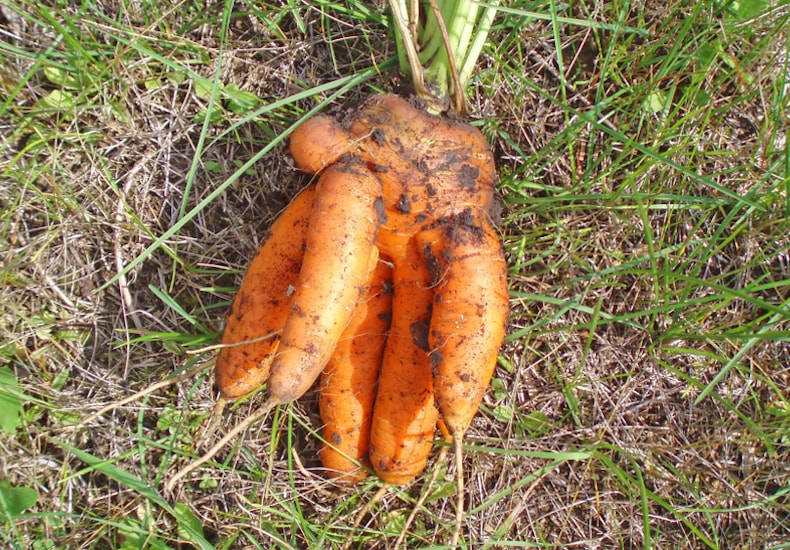
There are a couple of common issues you might face
Image: Napoleonka/Shutterstock
Forked roots are common when soil is heavy or rocky, or seeds are sown too close together and not thinned out. This is an aesthetic issue and shouldn’t affect the flavour of your vegetable.
Carrot fly is a common pest which can spoil a whole crop. Larvae burrow into the roots and leave them susceptible to rot. Unfortunately, once your crop is infested it’s not possible to reverse the damage so it’s best to be vigilant from the start. Here are some quick tips to help prevent carrot fly:
- Grow fly-resistant varieties such as ‘flyaway’ or ‘resistafly’ alongside a sacrifice crop of a non-resistant variety to lure the carrot fly larvae away.
- Thin out weaker plants in the evenings when flies are less active – the females are attracted to the smell of freshly pulled carrots and broken foliage.
- Cover the seedbed with horticultural fleece or clear plastic, at least 60cm high, or fine netting. This also helps ward off slugs, aphids, and other more benign garden pests.
- If your crop does become infested, rotate your carrots to a new location as carrot fly can remain in the soil and re-emerge the following spring.
Tips for growing carrots
If you want a quick visual recap, watch our short video tutorial for step-by-step tips on how to sow carrot seeds in the garden. Here are our top tips for growing carrots:
We hope you enjoy growing (and eating!) your carrots. Tag us in your photos if you share them on Facebook or Instagram - we’d love to see how you get on! Take a look at our hub page for more advice on growing carrots and parsnips.
Written by: Sue Sanderson
 Plants and gardens have always been a big part of my life. I can remember helping my Dad to prick out seedlings, even before I could see over the top of the potting bench. As an adult, I trained at Writtle College where I received my degree, BSc. (Hons) Horticulture. After working in a specialist plantsman's nursery, and later, as a consulting arboriculturalist, I joined Thompson & Morgan in 2008. Initially looking after the grounds and coordinating the plant trials, I now support the web team offering horticultural advice online.
Plants and gardens have always been a big part of my life. I can remember helping my Dad to prick out seedlings, even before I could see over the top of the potting bench. As an adult, I trained at Writtle College where I received my degree, BSc. (Hons) Horticulture. After working in a specialist plantsman's nursery, and later, as a consulting arboriculturalist, I joined Thompson & Morgan in 2008. Initially looking after the grounds and coordinating the plant trials, I now support the web team offering horticultural advice online.
Sign Up For Exclusive Special Offers




© 2024 Thompson & Morgan. All rights reserved. A division of Branded Garden Products Limited.



